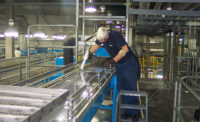For many facilities and sanitation personnel in the food and beverage industry, there is still some uncertainty about the benefits and effectiveness of dry steam cleaning. Goodway Technologies is sharing information on why dry steam cleaning is an economical, eco-friendly, and effective cleaning method.
“Dry steam cleaning is quickly gaining popularity within the food and beverage industry when it comes to cleaning and sanitizing,” said Evan Reyes, Goodway Technologies Director of Sales, Sanitation Division. “Dry steam is built for dry-clean only environments. There is more pressure on facility and maintenance personnel to be proactive in preventing any possible risks, and dry steam cleaning can be an effective solution that doesn’t require the labor or downtime necessary for other solutions.”
Where is Dry Steam Cleaning Applicable?
Dry steam cleaning is ideal when performing deep cleaning or sanitizing a facility or equipment where water needs to be minimized or avoided because it produces as little as 5% moisture content. The low moisture content means it is safe for use around electrical equipment and sensitive packaging areas but still offers the sanitizing and cleaning power of “regular” steam.
Using water vapor to clean and sanitize, dry steam offers a robust solution in spaces where chemical cleaning is not preferred. Dry steam cleaning also eliminates concerns about using harsh chemicals that may impact employee safety and the environment's health. The high temperatures can kill microorganisms and remove allergens from the surface on contact, leaving equipment dry and ready for immediate use.
How Does it Work?
Water is turned to steam, which in turn is superheated to a temperature of 290°F and pressurized to provide powerful cleaning and sanitizing properties. The technology delivers a powerful cleaning stream that obliterates substances such as stubborn grease, oil, dirt, and other residues from surfaces, even cracks, and crevices, without any need for chemicals. Additionally, mold and various bacteria are instantly eradicated, reducing microorganism counts and helping to remove allergens. And it does it all while using very little water and leaving little residual moisture.
Where Should I Start?
The first step is understanding which applications are a candidate for dry steam cleaning. Those that are “dry cleaning” only environment or have sensitivity to water and moisture are ideal. Look for applications where chemicals are not ideal or hard to reach areas where pressurized air isn’t ideal. Keep in mind potential risk factors that are associated with the product and the equipment design. If needed, consider hiring an outside consultant or contact Goodway sanitation experts to help assess the facility and equipment to determine the best approach.
Once the appropriate dry steam cleaning applications have been determined, and if required by your Sanitation Standard Operating Procedure (SSOP), it is important to evaluate the results to ensure it will achieve ATP swab, allergen, or microlevel cleanliness required to ensure product quality and food safety.
Find the Right Equipment
Goodway works closely with its customers to incorporate dry steam cleaning into its overall sanitation program. Every facility is unique, which is why Goodway’s experts help to find the most appropriate dry steam solution for the job. From industrial dry steam belt cleaning solutions to heavy-duty dry steam cleaners, it’s critical to invest in the right solution for the task at hand to get the best results. Check out the Goodway Dry Steam Buying Guide for help determining your exact needs.
Visit the website to learn more about the Goodway dry steam cleaning and sanitation solutions.






Report Abusive Comment